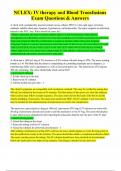Exam (elaborations)
NCLEX: IV therapy and Blood Transfusions Exam Questions & Answers
- Course
- Institution
NCLEX: IV therapy and Blood Transfusions Exam Questions & Answers -A client with a peripherally inserted central venous catheter (PICC) in the right upper extremity suddenly exhibits chest pain, dyspnea, hypotension, and tachycardia. The nurse suspects an embolism related to the PICC line. What sho...
[Show more]



